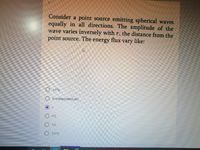
College Physics
11th Edition
ISBN: 9781305952300
Author: Raymond A. Serway, Chris Vuille
Publisher: Cengage Learning
expand_more
expand_more
format_list_bulleted
Question

Transcribed Image Text:Consider a point source emitting spherical waves
equally in all directions. The amplitude of the
wave varies inversely with r, the distance from the
point source. The
energy
flux
vary
like:
O 1/r^2
O Is independent of r
r
r^2
1/r
O 1/r^3
O O O O OO
Expert Solution
This question has been solved!
Explore an expertly crafted, step-by-step solution for a thorough understanding of key concepts.
This is a popular solution
Trending nowThis is a popular solution!
Step by stepSolved in 2 steps

Knowledge Booster
Learn more about
Need a deep-dive on the concept behind this application? Look no further. Learn more about this topic, physics and related others by exploring similar questions and additional content below.Similar questions
- A dielectric material has an absorption coefficient of 0.25 cm−1. A plate of thickness 3 cm is made from this material, and light with intensity 20 W m−2 is incident on the front. Ignoring reflection losses, calculate the intensity transmitted through the plate.Give your answer as a decimal to 2 d.p.arrow_forwardThe photoelectric effect is when light knocks electrons off the surface of a material. If you're shinning light on a surface and electrons are being knocked off, what could you change about the light so that it would stop knocking electron off? O Reduce the frequency of the light. O Increase the amplitude/intensity of the light. O Increase the frequency of the light. O Reduce thc wavelength of the light.arrow_forwardh) The difference in arrival time between wave-packets with centre frequencies of ω1 and ω2 is Δt. What is DM in terms of Δt ?arrow_forward
- 1. A plane wave in air is incident normally upon the surface of a lossless, nonmagnetic dielectric medium with relative electrical permittivity of 25 at z=0. Incident E field has an amplitude of 10 V/m polarized in +x direction and is of frequency 1 Ghz. Give the total E-field Phasor expression in air. 2. For the problem (1), determine the average power density of the reflected wave, and that of the transmitted wave. 3. Define and explain standing wave ratio. (Give a verbal description and the associated expressions) 4. For the problem (1), sketch the E-field wave pattern (Amplitude versus distance from the boundary) in air medium, indicating all critical vales and compute the standing wave ratio in the medium.arrow_forwardA sample of 1H in the equilibrium condition in a static magnetic field BO is excited by a short circularly polarized RF pulse. The RF pulse is a magnetic field in the transverse plane B₁(t) = B₁(t)e-i²πvot G₂ where vo is the Larmor frequency of the sample. The envelope of the RF pulse is a triangle function with parameter T: (1-7), 0≤t≤2T otherwise B₁ (t)= = { 0, (a) Find the tip angle of the magnetization vector as a function of t for 0 ≤ t ≤ 2T. (b) What is the value of T to make B1(t) a π/2 pulse?arrow_forwardAn argon gas laser produces a cylindrical beam of light having a cross sectional area A = 4 x 10-6 m². The average power of the beam is P. It is found that the average energy stored in 3 m length of the beam is 30 nJ. What is P? (1 nj = 10-9 J) Hig 30 nW 3 W 6 Warrow_forward
- An electric field in a vacuum is determined to be polarized in the +y-direction. It has a peak of 250 μV/m at z = 0, and the next peak is at z = 5 cm. Determine phase velocity, propagation constant, wavelength, period, frequency, and radial frequency for this wave and write a complete function for e(z,t). Complete Solution pleasearrow_forwardA 1000 W carbon-dioxide laser emits light with a wavelength of 10μm into a 3.0-mm-diameter laser beam. What force does the laser beam exert on a completely absorbing target?arrow_forwardLight with an intensity of 10−10W/m2 is shone perpendicular to the surface a metal that has one free electron per atom. Distance between atoms approx 2, 6A˚. Based on the notion of light as a wave and the assumption that light evenly distributed over the entire metal surface, (a) how much energy each electrons per second? (b) if the electron binding energy is 4.7eV , how long does the electron collect energy to escape the metal surface?arrow_forward
arrow_back_ios
arrow_forward_ios
Recommended textbooks for you
 College PhysicsPhysicsISBN:9781305952300Author:Raymond A. Serway, Chris VuillePublisher:Cengage Learning
College PhysicsPhysicsISBN:9781305952300Author:Raymond A. Serway, Chris VuillePublisher:Cengage Learning University Physics (14th Edition)PhysicsISBN:9780133969290Author:Hugh D. Young, Roger A. FreedmanPublisher:PEARSON
University Physics (14th Edition)PhysicsISBN:9780133969290Author:Hugh D. Young, Roger A. FreedmanPublisher:PEARSON Introduction To Quantum MechanicsPhysicsISBN:9781107189638Author:Griffiths, David J., Schroeter, Darrell F.Publisher:Cambridge University Press
Introduction To Quantum MechanicsPhysicsISBN:9781107189638Author:Griffiths, David J., Schroeter, Darrell F.Publisher:Cambridge University Press Physics for Scientists and EngineersPhysicsISBN:9781337553278Author:Raymond A. Serway, John W. JewettPublisher:Cengage Learning
Physics for Scientists and EngineersPhysicsISBN:9781337553278Author:Raymond A. Serway, John W. JewettPublisher:Cengage Learning Lecture- Tutorials for Introductory AstronomyPhysicsISBN:9780321820464Author:Edward E. Prather, Tim P. Slater, Jeff P. Adams, Gina BrissendenPublisher:Addison-Wesley
Lecture- Tutorials for Introductory AstronomyPhysicsISBN:9780321820464Author:Edward E. Prather, Tim P. Slater, Jeff P. Adams, Gina BrissendenPublisher:Addison-Wesley College Physics: A Strategic Approach (4th Editio...PhysicsISBN:9780134609034Author:Randall D. Knight (Professor Emeritus), Brian Jones, Stuart FieldPublisher:PEARSON
College Physics: A Strategic Approach (4th Editio...PhysicsISBN:9780134609034Author:Randall D. Knight (Professor Emeritus), Brian Jones, Stuart FieldPublisher:PEARSON

College Physics
Physics
ISBN:9781305952300
Author:Raymond A. Serway, Chris Vuille
Publisher:Cengage Learning

University Physics (14th Edition)
Physics
ISBN:9780133969290
Author:Hugh D. Young, Roger A. Freedman
Publisher:PEARSON

Introduction To Quantum Mechanics
Physics
ISBN:9781107189638
Author:Griffiths, David J., Schroeter, Darrell F.
Publisher:Cambridge University Press

Physics for Scientists and Engineers
Physics
ISBN:9781337553278
Author:Raymond A. Serway, John W. Jewett
Publisher:Cengage Learning

Lecture- Tutorials for Introductory Astronomy
Physics
ISBN:9780321820464
Author:Edward E. Prather, Tim P. Slater, Jeff P. Adams, Gina Brissenden
Publisher:Addison-Wesley

College Physics: A Strategic Approach (4th Editio...
Physics
ISBN:9780134609034
Author:Randall D. Knight (Professor Emeritus), Brian Jones, Stuart Field
Publisher:PEARSON